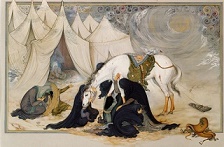Rawza-Khani
| Mourning of Muharram |
|---|
| Events |
| Figures |
| Places |
| Occasions |
| Rituals |
A Rawza-Khani is a Shiʻite ritual sermon recounting and mourning the death and martyrdom of the prophet of Islam, Shia imams and other sacred people and events including seventh-century tragedy of Karbala, which was a battle in which the Prophet's grandson Imam Hussain was martyred (in what is viewed by the Shiʻa as a heroic struggle against religious tyranny and corruption). The primary catalyst in the emergence of this ritual was the appearance of Hussain Vaez Kashifi's 1502 composition entitled Rawzat al-shuhada (The garden of martyrs). Rawza-khanis are performed in homes, mosques, Takiyas, Hussainiyas, religious sites, and even in the streets and bazaars of cities. The rawza-khani is a ritual in which a sermon is given based on a text like the Rawzat al-shuhada, with a great deal of improvisation on the part of the specially trained speaker. [1]
Evolution of Rawza-Khani[edit | edit source]
Literature dedicated to the martyrs of Karbala and other Shiʿite sacred figures, in Arabic and Persian, about the Ahl-e Bayt, particularly Hussain and the Karbala martyrs, was increasingly composed by authors of both Shiʿite and Sunnite persuasion. Under the Seljuqs (1038-1194), this devotional literature spread widely through storytellers. During this time, elegies (marathi) and eulogies (manaqeb) continued to be composed, in Arabic, Persian, and Turkish, by learned theologians, poets, and popular storytellers. A major synthesis of maqatel and manaqeb literature was provided by Hussain Vaez Kashifi (d. 910/1504-05) in his Rawzat al-shuhada. During the imposition of Twelver Shiʿism by the Safavids (1501-1722), Kashifi’s work became the textbook of preachers, thus called rawza-khans, who also continued to use material from epic, elegiac, theological, and historical literature. Along with Kashifi’s book, the celebrated Mohtasham Kashani’s (d. 996/1587 or 1000/1591) Davazdah band on the tragedy at Karbala was used extensively in Muharram ceremonies and served as an unrivalled model for further elegies, homilies, and dirges. [2]
The Goal of Rawza-Khani[edit | edit source]
The objective of the speaker is to move the audience to tears through his recitation of the tragic details of the Battle of Karbala. In addition to serving social, political, and psychological functions, this type of mourning ritual has been viewed by Shi’a as a means of achieving salvation. This belief is illustrated by the often-repeated Shi'ite quotation, “Anyone who cries for Hussain or causes someone to cry for Hussain shall go directly to paradise." [3]
Source[edit | edit source]
- Kamran Aghaie, (2004). Encyclopedia of Islam and Muslim World. Edited by Richard C. Martin. USA: Macmillan; P: 574. ISBN 0-02-865912-0
- Iranica Online website
Reference[edit | edit source]
- ↑ Kamran Aghaie (2004). Encyclopedia of Islam and Muslim World. Edited by Richard C. Martin. USA: Macmillan, P. 574. ISBN 0-02-865912-0.
- ↑ Hussain ibn Ali in popular Shi’ism at Encyclopedia Irannica. http://www.iranicaonline.org/articles/hosayn-b-ali-ii.
- ↑ Kamran Aghaie (2004). Encyclopedia of Islam and Muslim World. Edited by Richard C. Martin. USA: Macmillan, P. 574. ISBN 0-02-865912-0.
